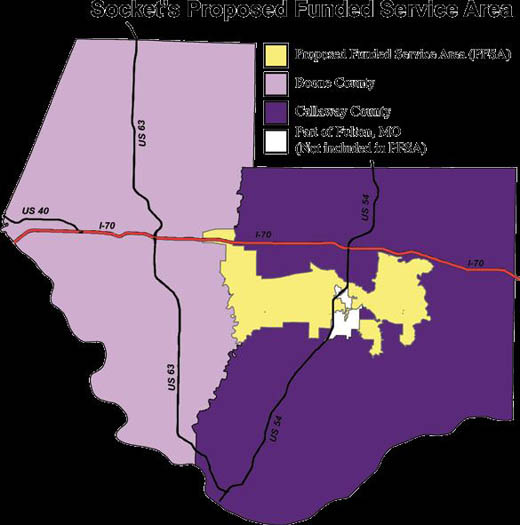Socket lands Callaway broadband project

“Big city broadband. Rural reality.”
That’s how Socket Telecom is touting the fiber-optic network it’s set to build in central Callaway County and a sliver of eastern Boone County.
This month the US Department of Agriculture awarded Socket a $16.6 million grant and a $7.1 million loan under the federal American Recovery and Reinvestment Act of 2009. Within the next 90 days, Socket will use that money to start building a fiber-optic network capable of serving more than 3,000 homes and businesses.
In the process, Socket will change as a company.
Until now, Socket has owned only bits and pieces of networks and resold access to networks owned by operators such as CenturyLink.
Socket will own the fiber-to-the-home network that it is building. The fast-growing, 16-year-old Columbia company, which has about 100 employees, also said it might bid for similar projects next year.
Although the federal program’s goal is to increase broadband access in rural towns and other underserved areas, Socket is free to use the network for other services, including TV, a new market segment for the company. By offering a package of phone, TV and broadband — known in the industry as a “triple play” — Socket hopes to attract more revenue and customers than if it offered only one or two services.
“We feel that will improve the take rate by having a triple play,” said Carson Coffman, Socket’s co-owner and vice president of sales and marketing.
The funding comes with a few strings attached. For example, if another service provider wants to lease Socket’s new network to offer competing services, Socket has to provide access.
“We’re totally comfortable with that,” Coffman said.
Socket also had to agree to build a majority of the network within two years of getting the money. Although the company plans to finish the entire project by early 2013, it will begin selling service in each area as it’s completed. Millersburg, a small community between Fulton and Columbia, likely will be first.
“We’ll have some people turned up after the first of the year,” Coffman said.

Rural areas frequently have limited or no access to broadband because it’s expensive to string or trench cable in sparsely populated areas.
With nearly $24 million in funding to reach more than 3,000 homes, schools and businesses, Socket will spend about $7,900 per new customer. By comparison Verizon, which uses the same FTTH technology as Socket, spends about $750 per home to wire up a suburban neighborhood, plus another $600 on additional construction for each household as it signs up for service.
Instead of building a fiber network, Socket could have used the existing copper phone lines in the area to offer DSL. But that decades-old infrastructure would have limited both the speeds that Socket could offer and the number of homes and businesses it could reach.
“It would have been a Band-Aid,” Coffman said. “It would have got people buying, but what we’re trying to do is get something a little more future-proof. [With fiber], we can do 70 to 80 Megabits per second to someone’s house.”
But at least initially, Socket will offer only 20 Mbps service. One reason is because despite all of the hype surrounding super-fast broadband networks — including Google’s proposed 1 gigabits-per-second network, which Columbia has bid for — the vast majority of consumers here and nationwide sign up for cheaper versions that deliver 1.5 to 12 Mbps. For example, earlier this year Time Warner Cable added 212,000 broadband customers, but only 1,000 of those chose its 50 Mbps service.
“From our experience, we don’t think a whole lot of people will buy even 20 Mbps,” Coffman said. “We think a lot will buy 5 and 10 Mbps. That probably will be plenty.
“It’s great to have the latest and greatest in everything you can give people, but if people don’t buy it, you’re wasting a lot of funding that you could use to go pick up more houses.”

Even so, Socket will have the capability of offering 50 to 100 Mbps services to businesses, schools and other customers that need that speed today, Coffman said. And as the consumer market for higher speeds grows, Socket could offer faster services by replacing the hardware that sits at either end of each fiber optic cable.
That future-proofing is another reason why Socket chose fiber. So is lower maintenance costs; fiber is less vulnerable to water damage than copper.
“The operators we’ve talked to have said, ‘Our maintenance costs have dropped since we went to fiber,’” Coffman said.
Yet another attraction is lower operational costs: Fiber uses up to 80 percent less electricity, said operators who recently replaced their copper infrastructure. There are additional savings because signals travel farther over fiber than copper. One Middle Eastern operator said that with copper, it needed a facility every 1.5 miles. With fiber, it has one only every 7.5 miles.
Even as construction begins, Socket is considering applying for more funding for similar projects elsewhere.
“There’s still a surplus of money available through the USDA to fund these rural development projects,” Coffman said. “So another possibility is to go back and do another loan application.
“After this is over, we believe that there will be a 2011 farm bill with a certain percentage of that budget allocated toward rural broadband expansion. That’s probably what we’ll try to line up with.”


